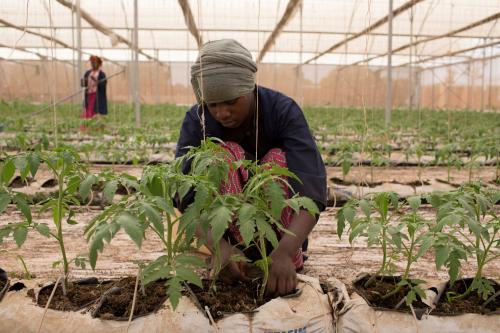The labor market is the main vehicle through which the proceeds of growth are shared among households and individuals. Therefore, understanding the labor market is essential for poverty reduction. This topic is crucial in Nigeria, where the government aspires to lift 100 million Nigerians out of poverty by 2030—an ambitious objective since, even before the pandemic, around 4 in 10 Nigerians lived below the national poverty line.
COVID-19’s “double shock”—health and economic—has intensified the need for new evidence to understand jobs and livelihoods in Nigeria. With social protection limited, households resorted to negative coping strategies—including reducing food consumption—that hurt their current and future welfare.
A new report, COVID-19 in Nigeria: Frontline Data and Pathways for Policy, uses high-frequency data to examine effects on human capital, livelihoods, and welfare. The report draws on the Nigeria COVID-19 National Longitudinal Phone Survey (NLPS), a distinctive, nationally-representative survey that captured key socioeconomic information from households for 12 consecutive rounds between April 2020 and April 2021.
Employment during COVID-19: Quick drop, quick recovery
The NLPS data show that employment in Nigeria plummeted at the start of the COVID-19 crisis. The share of main respondents in each household who were working fell by more than half between mid-March 2020 and April/May 2020, dropping from 86 percent to 42 percent (Figure 1). During this period, the most stringent lockdown measures were in place, and restrictions on mobility may have stopped people from getting to work. This also chimes strongly with global evidence from other labor markets.

Despite the initial drop, employment in Nigeria recovered quickly. By August 2020, the share of main respondents in each household who were working had returned to pre-pandemic levels. In this sense, Nigeria’s labor market echoed the V-shaped recovery observers hoped for in the global economy as a whole, following the COVID-19 crisis.
A closer look: Many people working, but not in good jobs
However, looking at the types of jobs Nigerians turned to paints a less positive picture. Later rounds of the NLPS—those implemented in September 2020 and February 2021—expanded interviews to all working-age household members, capturing more detailed and inclusive information on Nigeria’s labor market. The share of working-age Nigerians who were working actually increased between January-February 2019 and February 2021, but this was mainly concentrated in retail and trade (or commerce) activities in non-farm household enterprises. Such activities are typically small-scale—with only around 1 in 10 non-farm household enterprises employing anyone outside the household—so would be unlikely to help households ward off or escape poverty. Indeed, NLPS data directly demonstrate that non-farm enterprise income remained the most precarious—more so than wage work or agriculture—as COVID-19 continued.
Moreover, COVID-19 heralded significant churn in Nigerians’ labor market activities. Workers lacked stability and security in their employment: Instead, they took on whatever activities could help them cope with the effects of the COVID-19.
Learning losses place future growth at risk
Given its impacts on human capital development, and especially education, the crisis also threatens future generations. School closures during 2020 reduced children’s attendance rates even after reopening, especially among older children. Dropout was also higher in the households most affected by income shocks, suggesting that households removed children from school in order to support income-generating activities. Since Nigeria’s human capital outcomes were well below the average for sub-Saharan Africa even before the pandemic, the country can ill afford these setbacks to learning.
COVID-19 also threatens to widen inequality in learning, as access to remote learning was uneven across households. Young children from non-poor households had better access to remote learning options—through television, computers, and smartphones or tablets—than those from poor households (Figure 2).

A window for policy action
Recouping the learning lost during the COVID-19 crisis, therefore, presents a key policy priority for Nigeria. While encouraging children back to school—the preferred policy among Nigerians themselves—will be vital, resuming in-person learning requires that preventative measures be in place to prevent the virus’ spread. With ongoing uncertainty about the path of the pandemic, remote options that actually work for the poor are needed. High-tech options cannot reach the poor, so low-tech solutions may be more appropriate. Examples include engaging pupils, parents, and teachers through mobile phones or broadcasting lessons via radio. Further initiatives could support the recovery in learning, be it in person or remote: For example, there is growing evidence that Teaching at the Right Level (TaRL) can support foundational learning by carefully assessing children’s needs and then tailoring teaching accordingly.
The crisis also provides renewed impetus to implement the policies needed for good job creation in Nigeria. As well as investing in human capital, this partly hinges on effecting macroeconomic reforms to energize structural transformation and generate productive wage jobs. Yet, since farm and non-farm household enterprises will dominate employment in Nigeria for many years to come, policies to boost their productivity—through developing crop varieties, investing in infrastructure, improving market access, and easing credit constraints—should also be carefully considered.
The country’s large youth population makes it even more vital that Nigeria’s leaders apply evidence-based policies to exit the crisis and support the country’s workers, today and tomorrow.







Commentary
The COVID-19 crisis isn’t over for workers in Nigeria
November 24, 2021